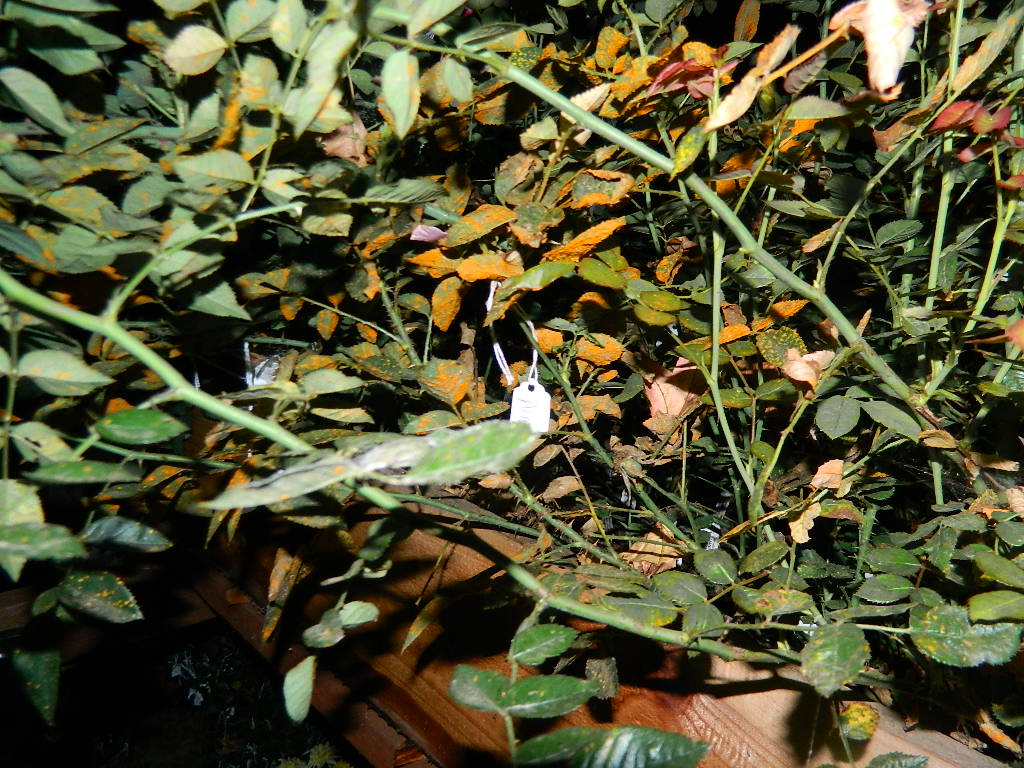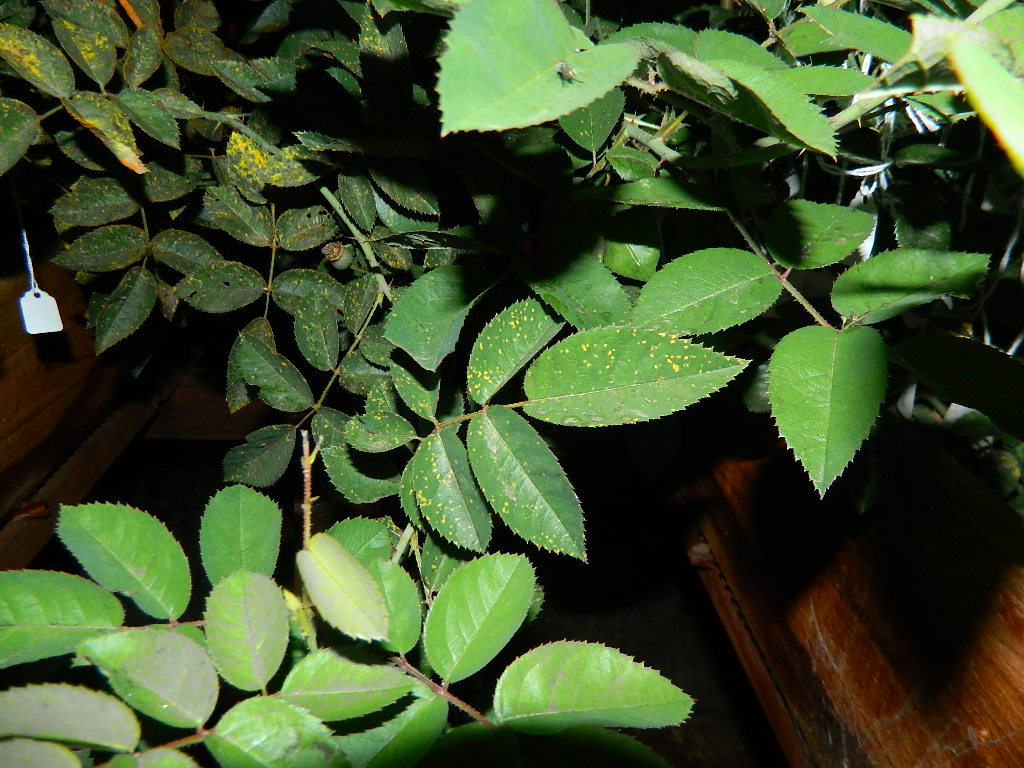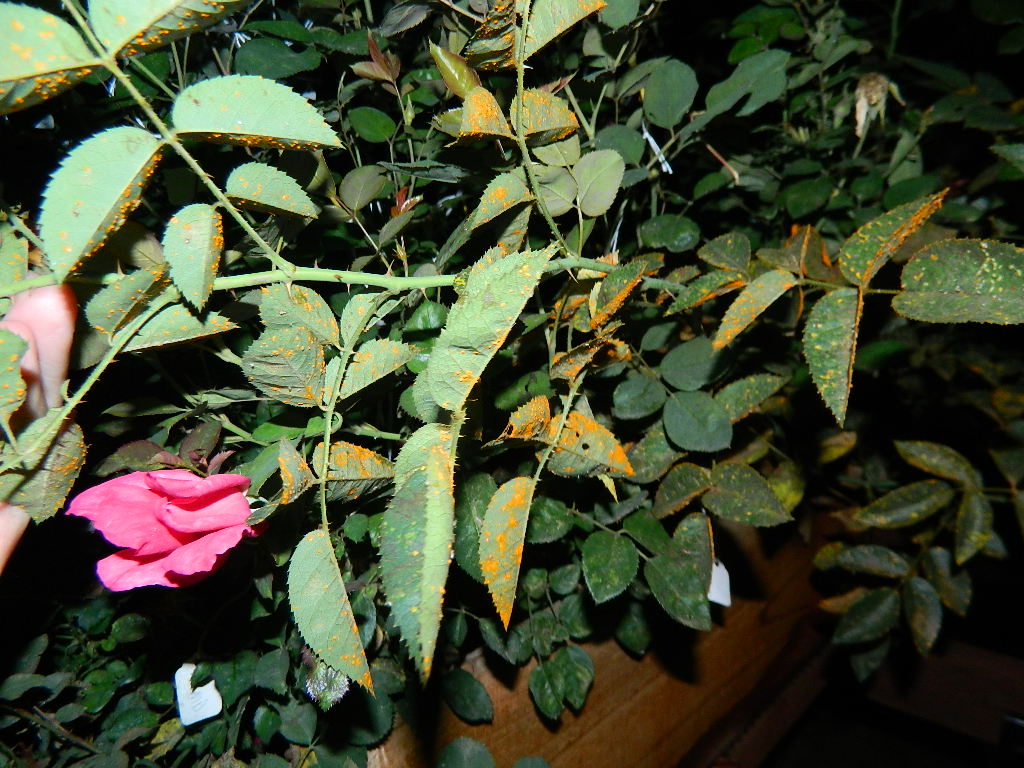No.
It doesn’t look like any rust I ever saw.
Peter
No.
It doesn’t look like any rust I ever saw.
Peter
Thank you Peter. This is on the hybrid alba, ‘Morning Blush’. The plant was free of any disease all season and end of August-beginning of September leaves started to develop this. When touched, the leaves will drop off.
How dry does the plant and pot get?
I had similar things happen to a lot of my potted plants after my move this year and late last fall. It was mainly because I neglected to keep them watered during some really dry parts of the year. While many of the plants seemed to shed their leaves, the ones that are generally more healthy and tend to keep their leaves for longer periods of time seemed to develop that type of an issue.
Do yours feel like dried leather like mine did - dried out but still pliable? After several good soakings mine come right back.
Andre,
I water my pots every day but during the 90+ degree period, the pots did get on the dry side during the day. It hasn’t seem to effect the plant and new growth continues to be put out. Thank you for the observation.
Rob,
That is simple heat stress. When plants get to big for their pots, the pots get to hot for the roots, or there is to much drying wind that desiccate the leaves and new growth before the roots can take up water as replacement, it is pretty easy to get that burnt crispy look. I have been watering every day for the last two weeks (rain, finally, today) and have had several do a little of this. Our cool night time temps have been around 80F-and if it was not so humid the plants would be worse off. You will know rust if and when you see it. I remember reading about the ‘pustules’ that rust form, and the first time I saw them, it fit the description perfectly–‘so this is what a ‘pustule’ looks like’, is the thought that went through my mind–it fits.
Jackie,
This definitely sounds like heat stress as you mention. Thank both you and Andre for the input. I’m relieved it’s not rust. Pustules…does not sound pretty.
Rob,
Basically we don’t get rust on roses on the East Coast. When I lived it Laguna Hills, CA and had roses, that was the first time I ever saw rust on roses. It is very distinctive. If there are hollyhocks in your neighborhood and some of the leaves look as if they are dying, if you can, look at the underside of the leaves and you might see the rust infections. They are very distinctive, raised, brick red round spheres. When I was in high school on Long Island, I had hollyhocks and they regularly got rust which caused the leaves to fall and the plants to decline. Incidentally the rust on hollyhocks and roses are different and do not cross over but are specific to the particular class of plants, much like mildew. The mildew on lilacs, dogwoods, and roses are specific to that group of plants.
Jim
That looks more like old foliage which the plant is preparing to drop by absorbing the sap from them, plus, perhaps a bit of sun scorch to the old, dying tissue. Now, THIS is rust. In the third photo, notice the golden spots on the upper surfaces of the foliage. The fourth photo is of their reverses.




If you would like some, I’m sure I can help…
Thank you Jim for the information. Kim those pictures sure make it clear what rust is. Boy, it sure is a nasty looking disease…
You’re welcome, Rob. Rust IS a nasty disease. Mildew I can live with as long as it is minor and fleeting. Rust has to be even less severe and more fleeting. It is to be expected toward the end of the season, but some are so addicted to it, they clutch it to their breasts and tightly hold it as a “badge”. Those I cure with steel…with a fiber glass handle!
lol. I would shovel prune anything that looked like those in the pictures too.
Unfortunately, those are all seedlings. I deliberately plant them densely to help determine which are going to be the most resistant. Believe it or not, there are several which are unaffected with ANY rust or mildew in those crowded, humid conditions. To further complicate the issue, there are aphids, spider mites and a heavy infestation of tiny ants, which are furiously collecting all the bait I place for them, but don’t appear to be experiencing knock-down from it yet. The ones remaining completely healthy will be given the best support when transplanted to push them along faster. The others will be given a chance, but watched even more closely for any issues which won’t clear up. And, they often do clear. There is one which started off vigorously and flowered immediately, but developed heavy mildew on every surface. I don’t spray nor use any chemical assistance for mildew other than water. When it began developing a strong basal, I pruned all the mildewed growth from the plant. The clean basal has remained clean…so far. There is a lot to be said for Ralph’s “testing by stress” method!
Yes, that is definitely rust, as only California can produce it. I used to see a lot of rust crop up in my seedlings until I started to unflinchingly cull for it. Now I am only seeing it in a very few light cases, mostly end of the yr stuff. As dry as it has been (not counting humidity in the 90’s+ for the last 2-3 weeks) I have not seen any this year, yet. And I did cut back on the water big time. Like mildew, it is pretty easy to select against, much more so than the spot diseases.